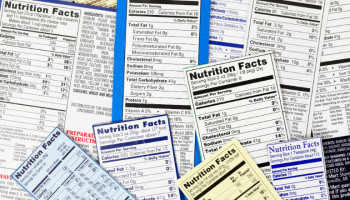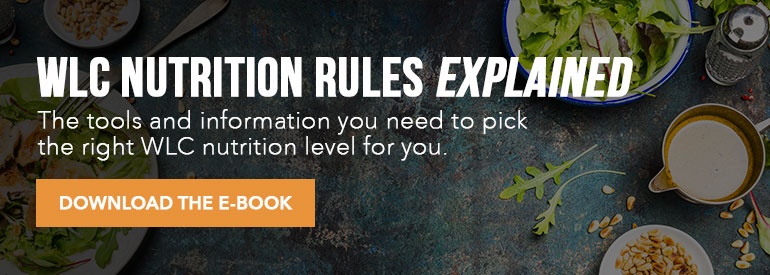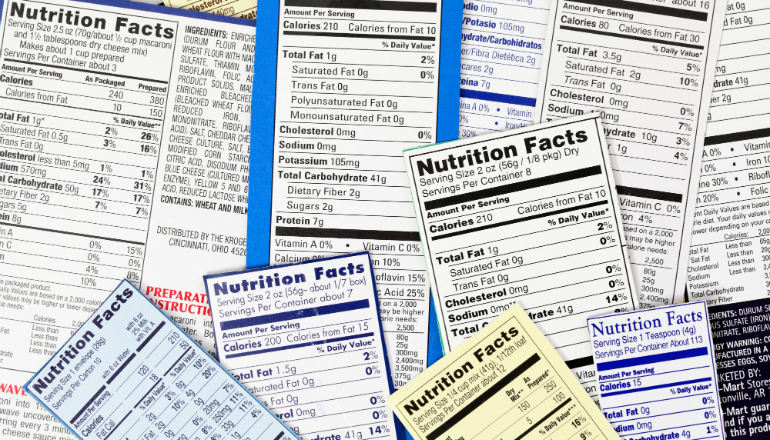 Reading Time: 8 minutes
Reading Time: 8 minutesA few years ago, I picked up my favorite energy bar and looked at the nutrition facts label.
I had a suspicion about these bars. They advertise simple, natural ingredients, and they are delicious and sweet—a little too sweet. I selected my favorite flavor and looked at the sugar content: eighteen grams.
I find “grams” hard to visualize and without a lot of meaning, so to give myself some context I divided eighteen by four—this is how you convert grams to teaspoons, which is a measurement I can get my head around. (There are actually 4.5 grams of sugar in one teaspoon, but dividing by four keeps it simple and quick.)
Eighteen divided by four is 4.5. That meant my favorite bar contained 4.5 teaspoons of sugar. Suddenly, that seemed like a lot. The American Heart Association recommends adult women consume only 5 teaspoons of sugar per day. They recommend 9 teaspoons for men and 3 teaspoons for children.
That one bar contained almost my entire sugar allotment for the day.
Once you make a habit of checking the labels of the foods you consume, you will have a clearer picture of what you’re ingesting and be able to achieve your nutrition, performance, and body composition goals that much more easily.
Learning how to read a nutrition facts label is important and empowering. But these labels are confusing—often deliberately so. So let’s crack the code together.
Servings and Calories
The first thing you’ll see on any nutrition label is the serving size and the number of servings per container. If a serving size is one cup, and the package contains two cups, eating the whole package means you’ll need to double all the numbers on the rest of the label. Double the calories, fat, sugar, carbohydrates—everything.
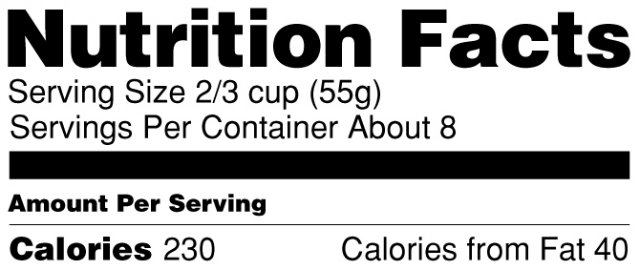
The next item on the label is the total calories. If you have an idea about how many calories you want to consume each day, this number is helpful. If you don’t count calories, this number can still help you to have a sense of the impact of the food you’re eating. The number to the right, the calories from fat, is less important than the type of fat, which is next on the label.
Fats
First you’ll see the total fat, followed by the amount of saturated fat, trans fat, and polyunsaturated and monounsaturated fat, if any.

Saturated fats are fat molecules that have no double bonds between carbon molecules because they are saturated with hydrogen molecules. They are most often found in animal products and are usually solid at room temperature, like butter. Many believe the consumption of saturated fats can increase the risk of cardiovascular disease and type 2 diabetes, although the details of this are increasingly debated.
Trans fat is the fat you most want to avoid, because it raises your LDL (“bad”) cholesterol and lowers your HDL (“good”) cholesterol. Some trans fat naturally occurs in meat and dairy products, but most is formed by adding hydrogen to vegetable oil — forming what is known as partially hydrogenated vegetable oil. Do your best to avoid foods with trans fat.
Be aware that in the United States, if a food contains less than 0.5 grams of trans fats in a serving, the label will show 0 grams of trans fat. To be sure about the fat content, take a look further down the label at the list of ingredients. If the food contains partially hydrogenated vegetable oil, then you know it does indeed have trans fats.
Next on the label are the so-called “healthy fats” — if your food item contains any polyunsaturated and/or monounsaturated fats it will be listed below trans fat.
- Polyunsaturated fats, like safflower, sesame, and sunflower seeds and their oils, are usually liquid at room temperature and when cold.
- Monounsaturated fats are liquid at room temperature, but solidify when cold. Examples of monounsaturated fats are canola, olive, and peanut oil, along with avocados.
Although no fats should be consumed with abandon, replacing saturated fats with unsaturated fats could help raise HDL cholesterol and lower LDL cholesterol.
Cholesterol
You may have grown up hearing about the importance of limiting your cholesterol intake, but in 2015, the Dietary Guidelines Advisory Committee of the United States changed its stance on cholesterol-laden foods. Experts now say we should not focus on the cholesterol in foods, but instead pay attention to foods high in saturated fats. For that reason, it’s more important to focus on the type of fats in your food rather than the cholesterol.

Sodium, Carbohydrates, and Protein
Sodium and carbohydrates, next on the label, are fairly straightforward. The American Heart Association recommends adults consume no more than 2,300mg of sodium a day — preferably 1,500mg. One teaspoon of salt contains 2,300mg of sodium, so it’s easy to reach that amount quickly. These guidelines don’t apply to people who lose large amounts of sodium in sweat, like competitive athletes, firefighters, or people who work in high heat environments.
Appropriate carbohydrate and protein amounts will vary depending on the specifics of your personal nutrition plan. But it’s important you’re aware of the amount of carbohydrates you consume, so you can make adjustments if needed.
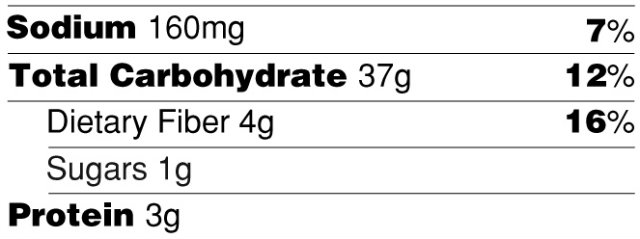
Fiber, Vitamins, and Minerals
Dietary fiber, vitamin A and C, calcium, and iron are all nutrients we want in our diet. Most Americans don’t get enough of these, but if you eat a variety of fruits and vegetables every day — especially green, leafy vegetables — you are likely in good shape.
Check your nutrition labels for these items — it’s an easy way to see if what you’re eating has any real nutritional value. Just because something is lacking “bad” things, doesn’t mean it’s full of “good” things.
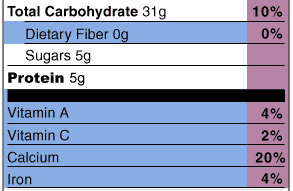
Sugar
Although sugar is fairly far down on the label, it’s one of the most important numbers to check. Once you start reading nutrition labels, you’ll be amazed how many prepared foods contain sugar.
The sugar listed on the label includes both added and naturally occurring sugar, although this will soon change. Starting in July 2018, nutrition labels will be required to show both the total grams of sugar and then separately indicate the amount of added sugar (see graphic below).

For now, you can see if a food has added sugar by looking at the list of ingredients. If you don’t see any sweeteners— which could be called corn syrup, high-fructose corn syrup, fruit juice concentrate, maltose, dextrose, sucrose, honey, agave, raw sugar, maple syrup, brown rice syrup, evaporated cane juice crystals, or a number of other names — the sugar is naturally occurring.
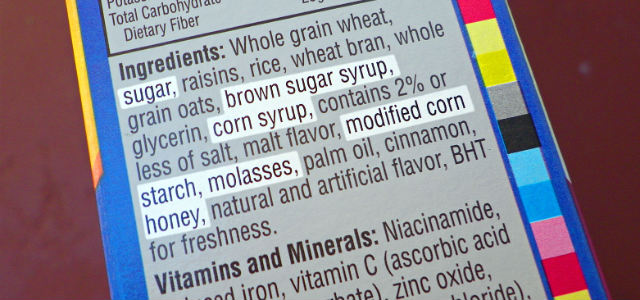
The Footnote
The nutrition facts label will not only show you the amount of nutrients in grams or milligrams, but you’ll also notice percentages on the far-right column, under the heading “% Daily Value.”
This column has an asterisk, with a footnote at the bottom of the label stating: “Percent Daily Values are based on a 2,000-calorie diet. Your daily values may be higher or lower depending on your calorie needs.” If there’s space on the label, the footnote also includes the recommended amount of fat, cholesterol, sodium, carbohydrates, and dietary fiber for a 2,000- or 2,500-calorie diet.
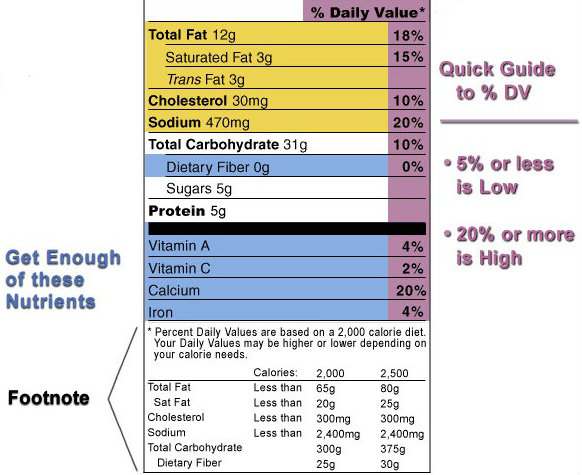
The percent daily value is helpful in showing you if a food is high or low in a certain nutrient. If a nutrient is 5% or less of the daily value, it’s low; if it’s above 20%, that’s high. Check these to see if a food is low in the things you want to keep an eye on — like fat and sodium — and high in vitamins, calcium, and iron.
While these percentages give you some context of how this food fits into a day of eating, your actual nutritional needs will vary depending on a range of lifestyle factors, so take this guideline with a grain of salt, so to speak.
Ingredient List
Food manufacturers are trying to sell product, and they frequently use words on the front of the package that are misleading and meaningless, like “all natural,” “light,” “made with real fruit,” “lightly sweetened,” and “organic.” The truth lies in the ingredient list. This is where the manufacturers must disclose exactly what’s in the food you’re buying.
It’s important to scan the ingredient list to make sure the product doesn’t contain any food you’re avoiding. It’s also valuable to know that ingredients are listed in order of weight, from most to least. So, if sugar, under any of its various names, is one of the first few ingredients, that means there’s a lot of sugar in the food.

Information Is Your Best Tool
Grocery shopping when trying to stick to a healthy diet can often feel overwhelming. Your best bet is to stick to the outside aisles of the store, buying mostly vegetables, fruits, and protein sources like fish, chicken, and lean meat.
However, sometimes life requires packaged foods. Once you learn how to read food labels you can gain control of your nutrition, and not fall victim to the claims on the front of the package.
Use this guide to take a look at the packaged foods in your cupboard. While you’re at it, teach your kids to read labels. Once I learned how to convert grams of sugar to teaspoons, I also taught my eight-year-old son and eleven-year-old daughter. Now they’ll pick up a box of granola bars and say, “Mommy, one bar has nine grams of sugar. That’s more than two teaspoons!”
Knowledge is power, and you’re never too young to become aware of the food you consume.
Additional Sources:
1. “How to Read Nutrition Facts Labels,” RealSimple.com.
2. “How to Understand and Use the Nutrition Facts Label,” U.S. Food & Drug Administration.
Cereal label photo (CC BY 2.0) by dno1967b.
Sugar ingredient list by Hglu23 (Own work) [CC BY-SA 3.0], via Wikimedia Commons.
